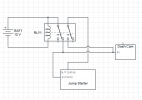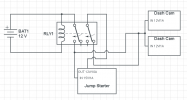thank you Phil, very kind of you.
i will be using a jump starter. it is able to power devices and be used to jump start the car if needed. also, total capacity in mAh tends do be almost double of common power banks. i will be placing it inside two lipo safe bags. i believe if i get unlucky i stand a good chance of not having a fire make much damage to the car, for what i could see of testing examples on Youtube. i have several goo options, for what i've been able to tell all Chinese made unfortunately, but i guess this is standardized well enough that even if they build a bad product it will still offer some good reliability, as long as you do not go for an obscure/un-reviewed brand. they usually have 18000mAh to 21000mAh, offer one 12V/10A output (some offer also another 19V/3.5A) and at least 2 USB 5V outputs with 1A or 2.1A and even USB-C outputs with quick chargers.
the jump starters have no pass through as you well noticed. so the circuitry has to switch on power from car battery to jump starter when the ignition is on and have the cams get power from the car battery, and when the ignition is switched off, the power to the cams comes from the jump starter that has also is charging from the car's battery stopped. basically what has been done in this thread.
given that i will have a two set of dual channel cams i will need two power outputs. but to make things more complicated, one of the sets (the BlackVue one) needs a 12V/1A input source: DC Plug

-)—C—(+) (Ø3.5 x Ø1.35). actually i just checked Thinkware and it also needs a 12V input... I was with the idea that it used a 5V input.
anyways, i discovered that there are step-up circuits that can receive 5V and transform to 12V output. Or i can simply use the examples here with a 12V circuit?
as you also mentioned, i can also have a splitter/hub for the cigar lighter or USB outputs. I am not sure however if these solutions are stable. i mean, they receive power from a source and then take the same power and output them at the same rate? 12V in and 12V out x2 or more outputs? i guess it is the same as power cord extensions...
since the two sets of dual channel cams (Blackvue and Thinkware) will work in tandem, then i guess i can just have one circuit designed as shown in this thread, but working on 12V, and having the output being feed to a 12V splitter/hub? maybe a dual cigar lighter port, and then just attach the cigar lighter sockets from the two sets to this.
having less wires and stripped wires would be a plus, so i still have to understand how this would work with a DPDT relay


